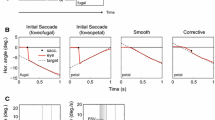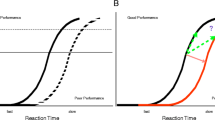Abstract
Antisaccades have not only longer latencies but also lower peak velocities than prosaccades. It is not known whether these latency and velocity differences are related. Studies of non-human primates suggest that prosaccade peak velocity declines as latency from target appearance increases. We examined whether a similar relationship between peak velocity and latency existed in human saccades, whether it accounted for the difference in peak velocity between antisaccades and prosaccades, and whether it was affected by schizophrenia, a condition that affects antisaccade performance. Sixteen control and 21 schizophrenia subjects performed prosaccade and antisaccade trials in the same test session. In both groups antisaccades had lower peak velocities than prosaccades. Latency did not influence the peak velocities of antisaccades in either subject group. At short latencies, the peak velocities of prosaccades were also similar in the two groups. However, while prosaccade peak velocities declined minimally with increasing latency in control subjects, those in the schizophrenia group declined significantly until they reached a value similar to antisaccade peak velocities. We conclude that, in normal subjects, the effect of latency on prosaccade peak velocity is minimal and cannot account for the lower velocity of antisaccades. In schizophrenia, we hypothesize that the latency-related decline in prosaccade peak velocity may reflect either an increased rate of decay of the effect of the transient visual signal at the saccadic goal, or a failure of the continuing presence of the target to sustain neural activity in the saccadic system.





Similar content being viewed by others
References
Bahill T, McDonald J (1983) Frequency limitations and optimal step size for the two-point central difference derivative algorithm with applications to human eye movement data. IEEE Trans Biomed Eng 30:191–194
Bahill AT, Clark MR, Stark L (1975) The main sequence, a tool for studying human eye movements. Math Biosci 24:191–204
Becker W (1989) Metrics. In: Wurtz RH, Goldberg ME (eds) The Neurobiology of saccadic eye movements. Elsevier Science, Amsterdam, pp 13–68
Berthoz A, Grantyn A, Droulez J (1986) Some colliculur efferent neurons code saccadic eye velocity. Neurosci Lett 72:289–294
Blair J, Spreen O (1989) Predicting premorbid IQ: a revision of the national adult reading test. Clin Neuropsychologist 3:129–136
Clementz BA, McDowell JE, Zisook S (1994) Saccadic system functioning among schizophrenia patients and their first-degree biological relatives. J Abnorm Psychol 103:277–287
Crawford TJ (1995) Saccadic abnormalities in psychotic patients. II. The role of neuroleptic treatment. Psychol Med 25:473–483
Crawford TJ, Puri BK, Nijran KS, Jones B, Kennard C, Lewis SW (1996) Abnormal saccadic distractibility in patients with schizophrenia: a 99mTc-HMPAO SPET study. PsycholMed 26:265–277
Crawford TJ, Sharma T, Puri BK, Murray RM, Berridge DM, Lewis SW (1998) Saccadic eye movements in families multiply affected with schizophrenia: the Maudsley Family Study. Am J Psychiatry 155:1703–10
Curtis CE, Calkins ME, Grove WM, Feil KJ, Iacono WG (2001) Saccadic disinhibition in patients with acute and remitted schizophrenia and their first-degree biological relatives. Am J Psychiatry 158:100–6
Doricchi F, Perani D, Incoccia C, Grassi F, Cappa SF, Bettinardi V, Galati G, Pizzamiglio L, Fazio F (1997) Neural control of fast-regular saccades and antisaccade: an investigation using positron emission tomography. Exp Brain Res 116:50–62
Dorris MC, Pare M, Munoz DP (1997) Neuronal activity in monkey superior colliculus related to the initiation of saccadic eye movements. J Neurosci 17:8566–8579
Edelman JA, Goldberg ME (2001) Dependence of saccade-related activity in the primate superior colliculus on visual target presence. J Neurophysiol 86:676–691
Everling S, Munoz DP (2000) Neuronal correlates for preparatory set associated with pro-saccades and anti-saccades in the primate frontal eye field. J Neurosci 20:387–400
First M, Spitzer R, Gibbon M, Williams J (1997) Structured clinical interview for DSM-IV axis I disorders, Research Version, Patient Edition with Psychotic Screen (SCID-I/P W/PSY SCREEN). Biometrics Research, New York State Psychiatric Institute, New York
Fischer B, Breitmeyer B (1987) Mechanisms of visual attention revealed by saccadic eye movements. Neuropsychologia 25:73–83
Fischer B, Weber H (1992) Characteristics of “anti” saccades in man. Exp. Brain Res. 89:415–424
Fukushima J, Morita N, Fukushima K, Chiba T, Tanaka S, Yamashita I (1990a) Voluntary control of saccadic eye movements in patients with schizophrenic and affective disorders. J Psychiatr Res 24:9–24
Fukushima J, Fukushima K, Morita N, Yamashita I (1990b) Further analysis of the control of voluntary saccadic eye movements in schizophrenic patients. Biol Psychiatry 28:943–958
Fukushima J, Fukushima K, Miyasaka K, Yamashita I (1994) Voluntary control saccadic eye movement in patients with frontal cortical lesions and parkinsonian patients in comparison with that in schizophrenics. Biol Psychiatry 36:21–30
Goldberg ME, Segraves MA (1989) The visual and frontal cortices. In: Wurtz RH, Goldberg ME (eds) The neurobiology of saccadic eye movements. Elsevier Science, Amsterdam, pp 283–314
Green J, King, DJ (1998) The effects of chlorpromazine and lorazepam on abnormal antisaccade and no-saccade distractibility. Biol Psychiatry 44:709–715
Hallett PE (1978) Primary and secondary saccades to goals defined by instructions. Vision Res 18:1279–1296
Hallett PE, Adams BD (1980) The predictability of saccadic latency in a novel voluntary oculomotor task. Vision Res 20:329–339
Hollingshead A (1965) Two factor index of social position. Yale University Press, New Haven CT
Hutton S, Kennard C (1998) Oculomotor abnormalities in schizophrenia. A critical review. Neurology 50:604–609
Hutton SB, Crawford TJ, Puri BK, Duncan LJ, Chapman M, Kennard C, Barnes TR, Joyce EM (1998) Smooth pursuit and saccadic abnormalities in first-episode schizophrenia. Psychol Med 28:685–92
Körner F (1975) Non-visual control of human saccadic eye movements. In: Lennerstrand G, Bach-y-Rita P (eds) Basic mechanisms of ocular motility and their clinical implications. Pergamon Press, Oxford, pp 565–569
Levy DL, Mendell NR, LaVancher CA, Brownstein J, Krastoshevsky O, Teraspulsky L, McManus KS, Lo Y, Bloom R, Matthysse S, Holzman PS (1998) Disinhibition in antisaccade performance in schizophrenia. In: Lenzenweger MF, Dworkin RH (eds) Origins and development of schizophrenia. American Psychological Association, Washington DC, pp 185–210
Manoach DS, Lindgren KA, Cherkasova MV, Goff DC, Halpern EF, Intriligator J, Barton JJS (2002) Schizophrenic subjects show deficient inhibition but intact task-switching on saccadic tasks. Biol Psychiatry 51:816–825
McDowell JE, Myles-Worsley M, Coon H, Byerley W, Clementz BA (1999) Measuring liability for schizophrenia using optimized antisaccade stimulus parameters. Psychophysiology 36:138–141
McDowell JE, Brown GG, Paulus M, Martinez A, Stewart SE, Dubowitz DJ, Braff DL (2002) Neural correlates of refixation saccades and antisaccades in normal and schizophrenia subjects. Biol Psychiatry 51:216–223
Muller N, Riedel M, Eggert T, Straube A (1999) Internally and externally guided voluntary saccades in unmedicated and medicated schizophrenic patients. Part II. Saccadic latency, gain, and fixation suppression errors. Eur Arch Psychiatry Clin Neurosci 249:7–14
Munoz DP, Dorris MC, Pare M, Everling S (2000) On your mark, get set: brainstem circuitry underlying saccadic initiation. Can J Physiol Pharmacol 78:934–944
Nakashima Y, Momose T, Sano I, Katayama S, Nakajima T, Niwa S, Matsushita M (1994) Cortical control of saccade in normal and schizophrenic subjects: a PET study using a task-evoked rCBF paradigm. Schizophr Res 12:259–264
O’Driscoll GA, Lenzenweger MF, Holzman PS (1998) Antisaccades and smooth pursuit eye tracking and schizotypy. Arch Gen Psychiatry 55:837–843
Raemaekers M, Jansma J, Cahn W, Van der Geest J, van der Linden J, Kahn R, Ramsey N (2002) Neuronal substrate of the saccadic inhibition deficit in schizophrenia investigated with 3-dimensional event-related functional magnetic resonance imaging. Arch Gen Psychiatry 59:313–320
Schwartz B, Winstead D (1988) Visible persistence in paranoid schizophrenics. Biol Psychiatry 23:3–12
Schwartz B, Wiknstead D, Adinoff B (1983) Temporal integration deficit in visual information processing by chronic schizophrenics. Biol Psychiatry 18:1311–1320
Schwartz B, Tomlin H, Evans W, Ross K (2001) Neurophysiologic mechanisms of attention: a selective review of early information processing in schizophrenics. Front Biosci 6:d120–d134
Smit A, van Gisbergen J (1989) A short-latency transition insaccade dynamics during square-wave tracking and its significance for the differentiation of visually guided and predictive saccades. Exp Brain Res 76:64–74
Sparks DL, Hartwich-Young (1989) The deep layers of the superior colliculus. In: Wurtz RH, Goldberg ME (eds) The neurobiology of saccadic eye movements. Elsevier Science, Amsterdam, pp 213–256
Straube A, Riedel M, Eggert T, Muller N (1999) Internally and externally guided voluntary saccades in unmedicated and medicated schizophrenic patients. Part I. Saccadic velocity. Eur Arch Psychiatry Clin Neurosci 249:1–6
Sweeney J, Bauer K, Keshavan M, Haas G, Schooler N, Kroboth P (1997) Adverse effects of risperidone on eye movement activity: a comparison of risperidone and haloperidol in antipsychotic-naive schizophrenic patients. Neuropsychopharmacology 16:217–228
van Gelder P, Lebedev S, Tsui WH (1997) Peak velocities of visual and nonvisually guided saccades in smooth-pursuit and saccadic tasks. Exp Brain Res 116:201–215
White K, Ashton R (1976) Handedness assessment inventory. Neuropsychologia 14:261–264
Author information
Authors and Affiliations
Corresponding author
Rights and permissions
About this article
Cite this article
Ramchandran, R.S., Manoach, D.S., Cherkasova, M.V. et al. The relationship of saccadic peak velocity to latency: evidence for a new prosaccadic abnormality in schizophrenia. Exp Brain Res 159, 99–107 (2004). https://doi.org/10.1007/s00221-004-1940-z
Received:
Accepted:
Published:
Issue Date:
DOI: https://doi.org/10.1007/s00221-004-1940-z




